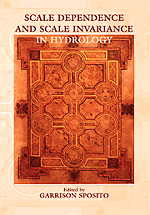Book contents
- Frontmatter
- Contents
- List of Contributors
- Preface
- 1 Scale Analyses for Land-Surface Hydrology
- 2 Hillslopes, Channels, and Landscape Scale
- 3 Scaling in River Networks
- 4 Spatial Variability and Scale Invariance in Hydrologic Regionalization
- 5 An Emerging Technology for Scaling Field Soil-Water Behavior
- 6 Scaling Invariance and the Richards Equation
- 7 Scaling of the Richards Equation and Its Application to Watershed Modeling
- 8 Scale Issues of Heterogeneity in Vadose-Zone Hydrology
- 9 Stochastic Modeling of Scale-dependent Macrodispersion in the Vadose Zone
- 10 Dilution of Nonreactive Solutes in Heterogeneous Porous Media
- 11 Analysis of Scale Effects in Large-Scale Solute-Transport Models
- 12 Scale Effects in Fluid Flow through Fractured Geologic Media
- 13 Correlation, Flow, and Transport in Multiscale Permeability Fields
- 14 Conditional Simulation of Geologic Media with Evolving Scales of Heterogeneity
- Index
4 - Spatial Variability and Scale Invariance in Hydrologic Regionalization
Published online by Cambridge University Press: 18 January 2010
- Frontmatter
- Contents
- List of Contributors
- Preface
- 1 Scale Analyses for Land-Surface Hydrology
- 2 Hillslopes, Channels, and Landscape Scale
- 3 Scaling in River Networks
- 4 Spatial Variability and Scale Invariance in Hydrologic Regionalization
- 5 An Emerging Technology for Scaling Field Soil-Water Behavior
- 6 Scaling Invariance and the Richards Equation
- 7 Scaling of the Richards Equation and Its Application to Watershed Modeling
- 8 Scale Issues of Heterogeneity in Vadose-Zone Hydrology
- 9 Stochastic Modeling of Scale-dependent Macrodispersion in the Vadose Zone
- 10 Dilution of Nonreactive Solutes in Heterogeneous Porous Media
- 11 Analysis of Scale Effects in Large-Scale Solute-Transport Models
- 12 Scale Effects in Fluid Flow through Fractured Geologic Media
- 13 Correlation, Flow, and Transport in Multiscale Permeability Fields
- 14 Conditional Simulation of Geologic Media with Evolving Scales of Heterogeneity
- Index
Summary
Problems of Scale and Regionalization in River Basins
The occurrence of the hydrologic cycle covers a very wide range of space and time scales, and involves physical, chemical, and ecological processes. Therefore, in modeling and making predictions, one is required to understand how various properties and measurements behave under a change of scale. At the spatial and temporal scales of interest in river basins, space–time variability and fluctuations are displayed in input, output, and storage elements of the components of the hydrologic cycle and in their interactions. This variability is part of the physics and in this sense is different from the measurement noise. We can use the term physical-statistical or statistical-dynamical to describe such systems. An understanding of the physics of these systems in the presence of variability and fluctuations through mathematical notions of randomness has been and continues to be one of the central challenges of hydrology and constitutes the main theme of this chapter.
A river basin contains a channel network, as shown in Figure 4.1, and systems of hills on both sides of the channels in the network. Rainfall and/or snowmelt are transformed into runoff, and sediments are eroded over hills, and these in turn are fed into a channel network for their journey toward an ocean. The hydrologic cycle on a hillside involves transformation of rainfall to surface runoff, infiltration through the near-surface unsaturated soils, and evapotranspiration from the soil surface into the atmosphere. The infiltrated water goes into recharging the soil moisture in the unsaturated zone, the aquifers, and some of it also appears as subsurface runoff in a channel network.
- Type
- Chapter
- Information
- Scale Dependence and Scale Invariance in Hydrology , pp. 88 - 135Publisher: Cambridge University PressPrint publication year: 1998
- 66
- Cited by

